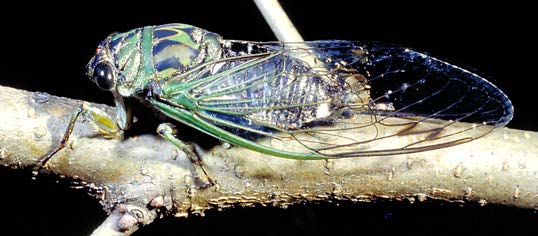By Craig Everett
Horticulturalist with OSU Extention in Wood County
Last week I heard someone say the Locusts are singing. This was followed up with – you know what this means? It means Fall is only six weeks away. The Locusts that they were referring to are not Locusts at all, they are Dog Day Cicadas. Dog Day Cicadas, like my good friend the Groundhog, are often used to predict the upcoming weather. So, is Fall only six weeks away? Time will tell!
Cicadas are large insects that occur worldwide and are commonly recognized for their unique sound. While often referred to as “Locusts” in the United States, they bear no relation to true Locusts, which are Grasshoppers. Cicadas are closely related to Leafhoppers and Spittlebugs.
The Dog Day Cicada is also called the Annual Cicada. The adults appear sporadically throughout the “Dog Days” of summer usually beginning in July. The State of Ohio has two types of Cicadas: The Dog Day Cicada and the Periodical Cicada. Only the Dog Day Cicada is found in Wood County.
Our annual Cicadas share several behavioral traits with Periodical Cicadas. The Nymphs of both types of Cicadas develop underground sustained by juices sucked from tree roots and it takes multiple years for them to complete their development from eggs to new adults.
Periodical Cicadas are so named because it takes 17 or 13 years for new adults to emerge in spring. Brood X (10) will emerge in Ohio next spring; however, in Van Wert County they saw and heard a few “early-birds” from this brood back in May and early June.
Periodical Cicadas are spring insects, while annual Cicadas are summer insects. Like their Periodical familial cousins, Dog Day Cicada males also “sing” to attract females. However, they do not “chorus” with large numbers synchronizing their song.
An occasional dog-day cicada buzzing to entice a female does not compare to the symphony created by a multitude of Periodical Cicadas. It is like comparing a barbershop quartet to a million-man chorus! If you want to hear the Periodical Cicada next spring a short drive south to Hardin County will fill your ears with their symphonic song.
Dog Day Cicadas develop more quickly compared to Periodical Cicadas. It takes 2-3 years for the Nymphs to complete their development; however, some adults emerge every year due to overlapping generations. The adults appear sporadically throughout the “Dog Days” of summer usually beginning in July.
Both Periodical Cicadas and Dog Day Cicada females use their long, spade-like ovipositors or stingers to insert eggs through the bark of twigs and into the soft white wood of trees. The resulting damage splits the bark leaving deep longitudinal furrows of ruptured tissue. The injury often causes the twig to die, the leaves to turn brown, with the dead twig hanging onto the tree. This is known as flagging. Eventually the twig detaches and drops.
The appearance of our annual Dog Day Cicadas means their enemy, the Cicada killer Wasp should soon be seen cruising woodlands and landscapes in search of their exclusive prey. Cicada killers feed exclusively on annual Dog Day Cicadas. The timing with annual Cicadas makes sense if you consider that the wasps would starve to death waiting 13 or 17 years for a Periodical Cicada meal.
The wasps measure 1 1/8 to 1 5/8″ in length and are one of the largest wasps found in Ohio. As with all Hymenoptera or the family of Wasps, Bees, etc., only the females possess stingers or ovipositors. These female Wasps, however, are not aggressive. The males are aggressive, but they lack stingers.
The females spend their time digging and provisioning burrows with paralyzed Cicada Prey. They prefer to dig their brood burrows in bare, well-drained soil that is exposed to full sunlight. Although the Wasps are considered solitary, all the females have the same nesting requirements. So, it is not unusual for there to be numerous burrows, and Wasps, in relatively small areas.
The males spend their time establishing and defending territories that encompass multiple females. They are notoriously defensive and will aggressively buzz any by passer who dares to enter their territory including other males as well as Picnickers, Golfers, Volleyball enthusiasts, and Gardeners. Fortunately, it is all a rouse since they lack the necessary equipment to deliver a sting.
Although the males cannot sting, their large size coupled with low-level flights over sand volleyball courts, sparse lawns, and bare areas in landscapes can be annoying generating demands for control options. However, insecticide applications to kill the killers is not recommended.
Cicada killers are considered beneficial insects and the females are not aggressive; stinging encounters are very rare. The best way to manage Cicada killers if they appear where they are not wanted is to modify their habitat. Renovating lawns late this summer to thicken the turfgrass will keep the killers out of lawns. Applying mulch to cover bare soil or raking mulch to disturb and redistribute possible burrowing sites will convince females to nest elsewhere. The same is true for golf course sand traps and sand volleyball courts: periodical raking will prevent the wasps from becoming established.

